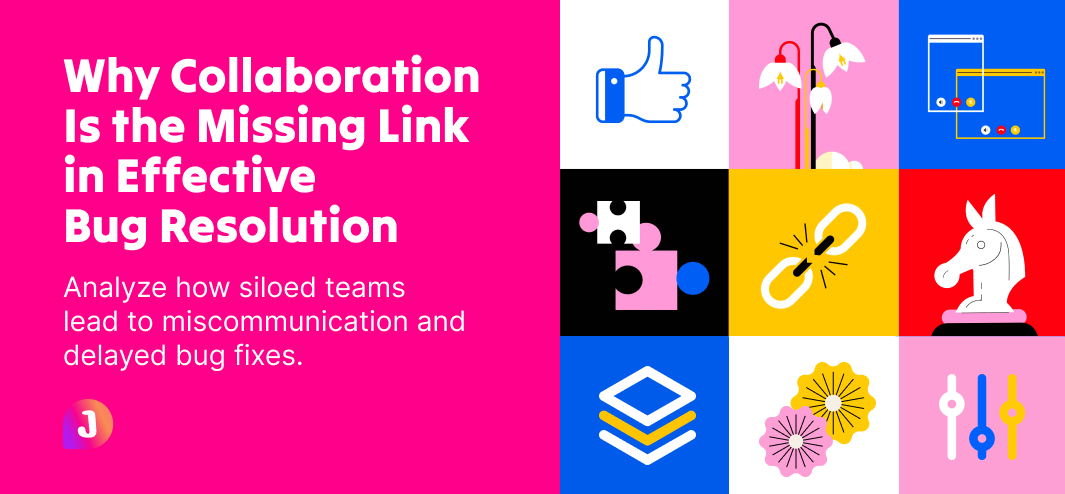Why Collaboration Is the Missing Link in Effective Bug Resolution

Bugs are an inevitable part of software development. Whether they’re minor UI glitches or critical functionality issues, identifying and resolving bugs is crucial to delivering high-quality software. Yet, for many development teams, debugging remains a frustrating, time-consuming bottleneck. Why? Because the process often lacks one key ingredient—effective collaboration.
Without a seamless flow of information and teamwork, even the most skilled developers, project managers, and QA engineers can find themselves stuck in endless cycles of miscommunication, duplicated efforts, and delayed fixes. This blog explores why collaboration is essential for bug resolution, how real-time communication fosters efficiency, and how tools like JotGo make collaborative debugging effortless.
The Problem with Siloed Teams in Bug Resolution
Siloed teams are one of the biggest barriers to smooth bug resolution. When developers, QA engineers, and project managers work in isolation, crucial information tends to get lost in translation. Each team member may operate in their specific tools or workflows, unaware of how their work impacts others or contributes to the bigger picture.
How Silos Cause Miscommunication
Picture this scenario: A QA engineer identifies a bug and reports it using a testing tool. The issue passes to a project manager, who adjusts its priority before forwarding it to the development team. Somewhere in the handoff process, key details—such as device specs, reproduction steps, or logs—are lost or unclear. The developer spends hours hunting for missing information or misinterprets what the bug entails, leading to wasted effort and frustration.
This back-and-forth occurs because siloed teams rely on fragmented communication channels. Miscommunication slows teams down and can even result in the bug being reopened multiple times if the root cause isn’t fully understood.
The Cost of Delayed Bug Fixes
Delayed resolution doesn’t just impact project timelines; it can create a ripple effect across the organization. Bugs left unresolved for too long can lead to:
- Missed deadlines
- Dissatisfied users
- Reduced team morale
- Higher maintenance costs for patching issues post-release
Simply put, fixing bugs in isolation or relying on outdated communication processes is no longer a sustainable approach in today’s fast-paced development world.
Why Collaboration Is Crucial for Resolving Bugs Quickly and Effectively
Effective bug resolution hinges on real-time collaboration and transparency. When all team members—developers, testers, project managers, even designers—work together seamlessly, every aspect of the debugging process becomes faster and more efficient.
The Power of Real-Time Collaboration
Imagine if the QA engineer in our earlier example could instantly share their findings—complete with screenshots, logs, and reproduction steps—directly with the developer working on the bug. Instead of spending time deciphering unclear notes or requesting more information, the developer could begin fixing the issue right away with full context.
Real-time collaboration allows for:
- Faster Identification – Bugs are diagnosed more quickly when communication is clear.
- Smarter Prioritization – Teams can discuss impact and urgency together rather than making decisions in isolation.
- Streamlined Problem Solving – Everyone, from testers to developers, can work in sync toward a solution without redundant tasks.
Cross-Team Transparency
Transparency is equally essential. When everyone involved in the debugging process has access to the same information—what’s been reported, who’s working on what, and what progress has been made—there’s no room for misunderstandings. Transparent workflows eliminate bottlenecks and ensure accountability.
Transparent collaboration tools also allow stakeholders, such as product managers or customer support teams, to track progress. This visibility reassures them that issues are being addressed, reducing anxiety and misaligned expectations across departments.
How JotGo Simplifies Bug Resolution with Collaborative Features
At JotGo, we believe bug resolution shouldn’t feel like a scavenger hunt. That’s why we’ve built a collaborative debugging platform designed to eliminate silos, reduce miscommunication, and fast-track issue resolution. Here’s how JotGo transforms the process:
1. Capture Bugs with Rich Context
JotGo’s intuitive bug reporting tool allows QA teams to capture every detail in one go. Our platform auto-imports key data, such as device info, browser type, operating system, and even screenshots or screen recordings, so developers receive what they need upfront—no back-and-forth required.
2. Centralize Communication in One Place
Say goodbye to scattered Slack threads or endless email chains. With JotGo, all discussions about a bug happen within the platform, right next to the issue itself. Comments and annotations can be added in real-time, so testers, developers, and managers stay on the same page at all times.
3. Real-Time Updates for Everyone
JotGo ensures cross-team transparency by syncing updates automatically. When a developer resolves an issue, automated notifications inform QA engineers and project managers in real time, reducing delays caused by manual follow-ups.
4. Integrated Workflows with Your Favorite Tools
Already using Jira or Trello to manage tasks? JotGo easily integrates with popular project management tools, so there’s no need to change your current workflow. Centralized collaboration enhances, not disrupts, your operations.
5. Comprehensive Reporting and Analytics
Want to see how well your team is tackling bugs? JotGo’s analytics dashboard provides insights into resolution times, recurring issues, and team performance, empowering you to refine your debugging process over time.
Collaboration Is Your Competitive Advantage
The days of siloed bug resolution are over. Forward-thinking teams are leveraging collaborative tools to work smarter, resolve issues faster, and deliver better products to market. And the organizations that get this right don’t just gain efficiency—they build a culture of seamless teamwork that fosters innovation and trust.
If you’re ready to say goodbye to miscommunication and delayed fixes, it’s time to see what JotGo can do for your team. Sign up for a free trial today and experience the power of streamlined collaboration in bug resolution.











